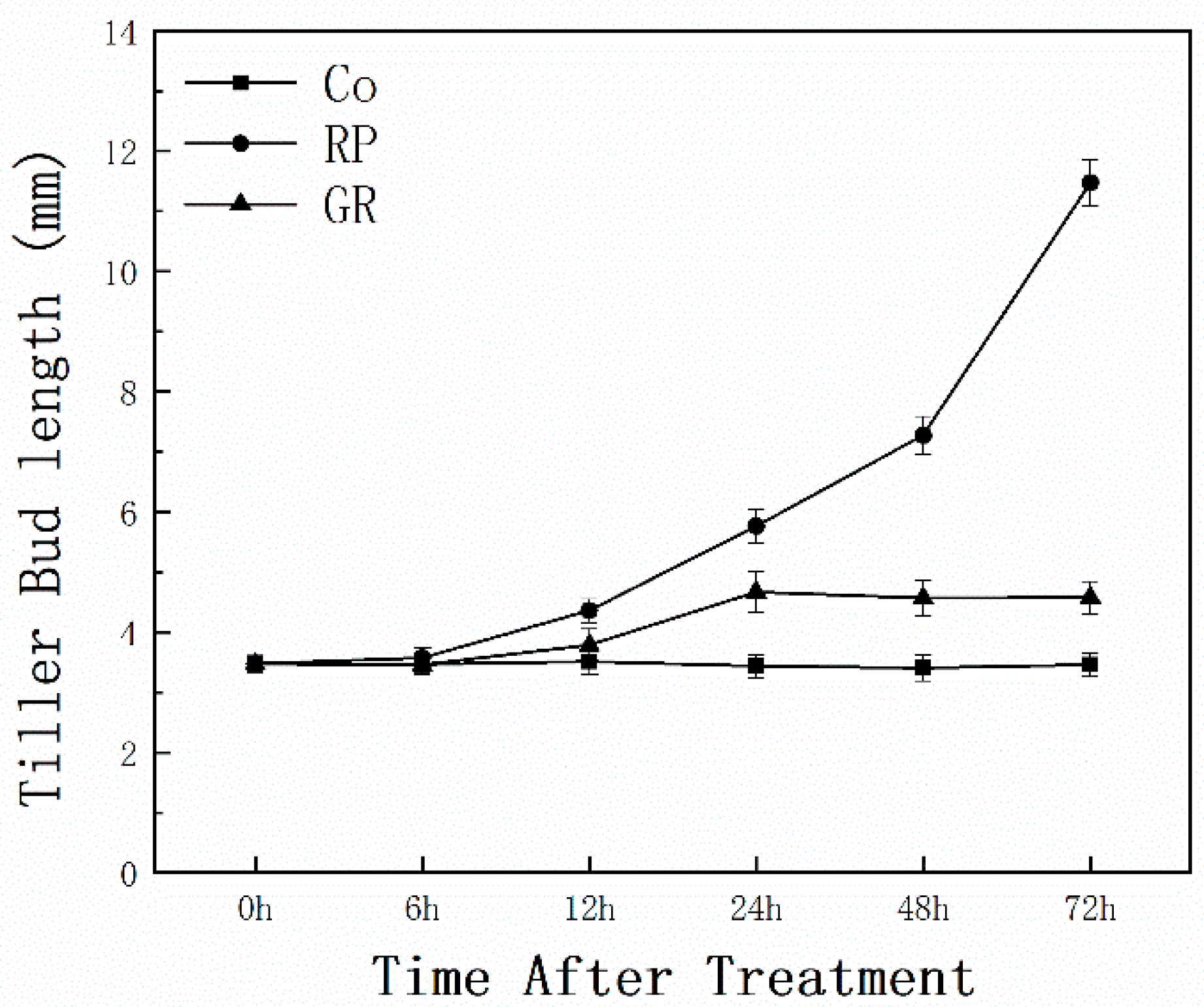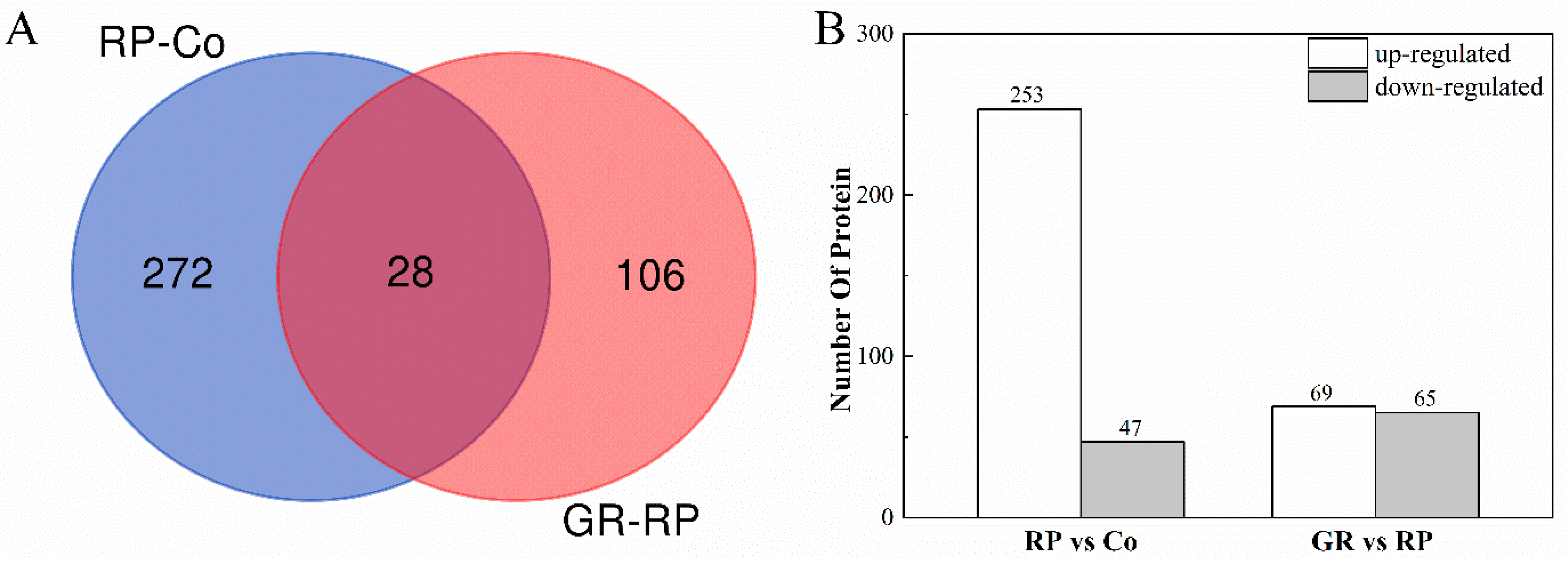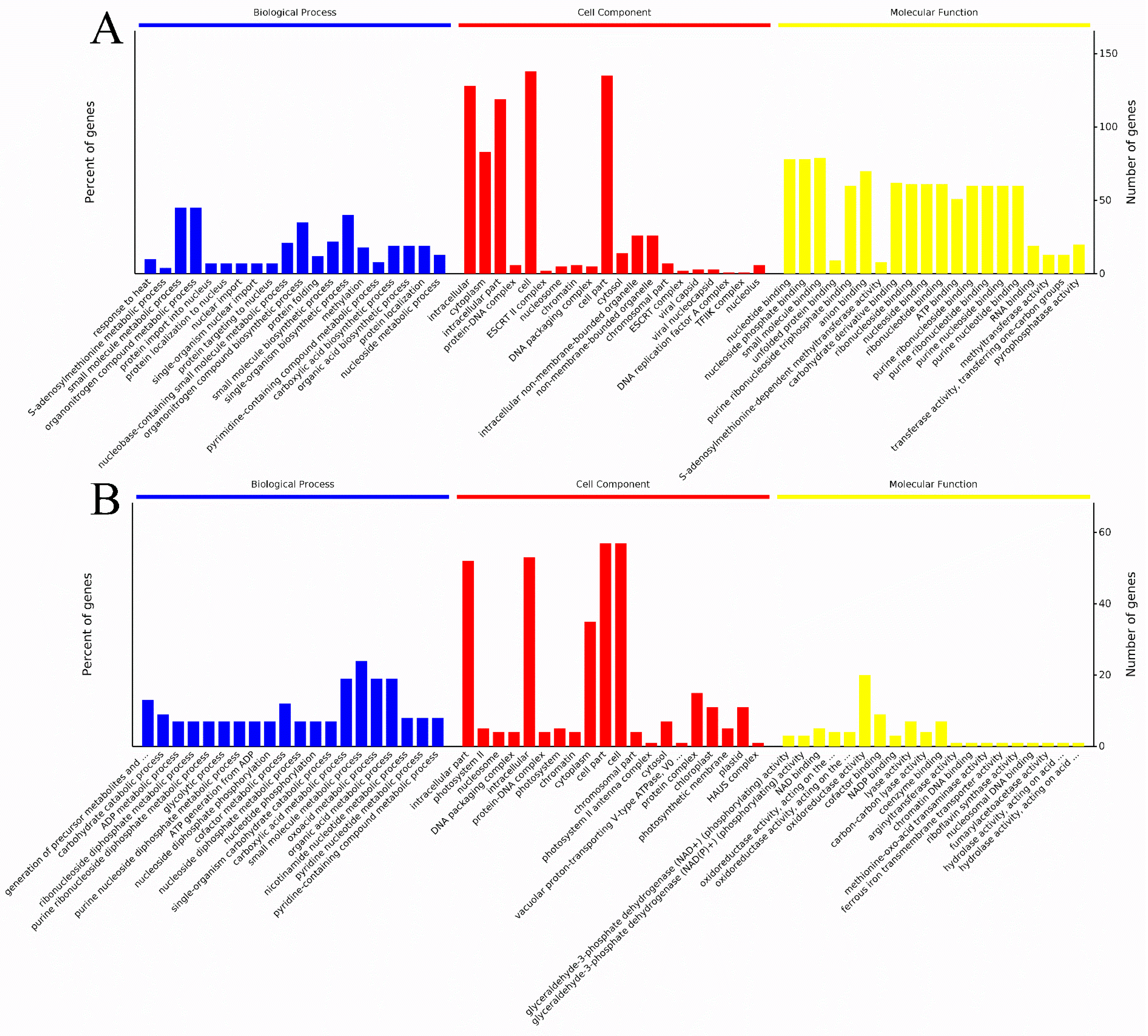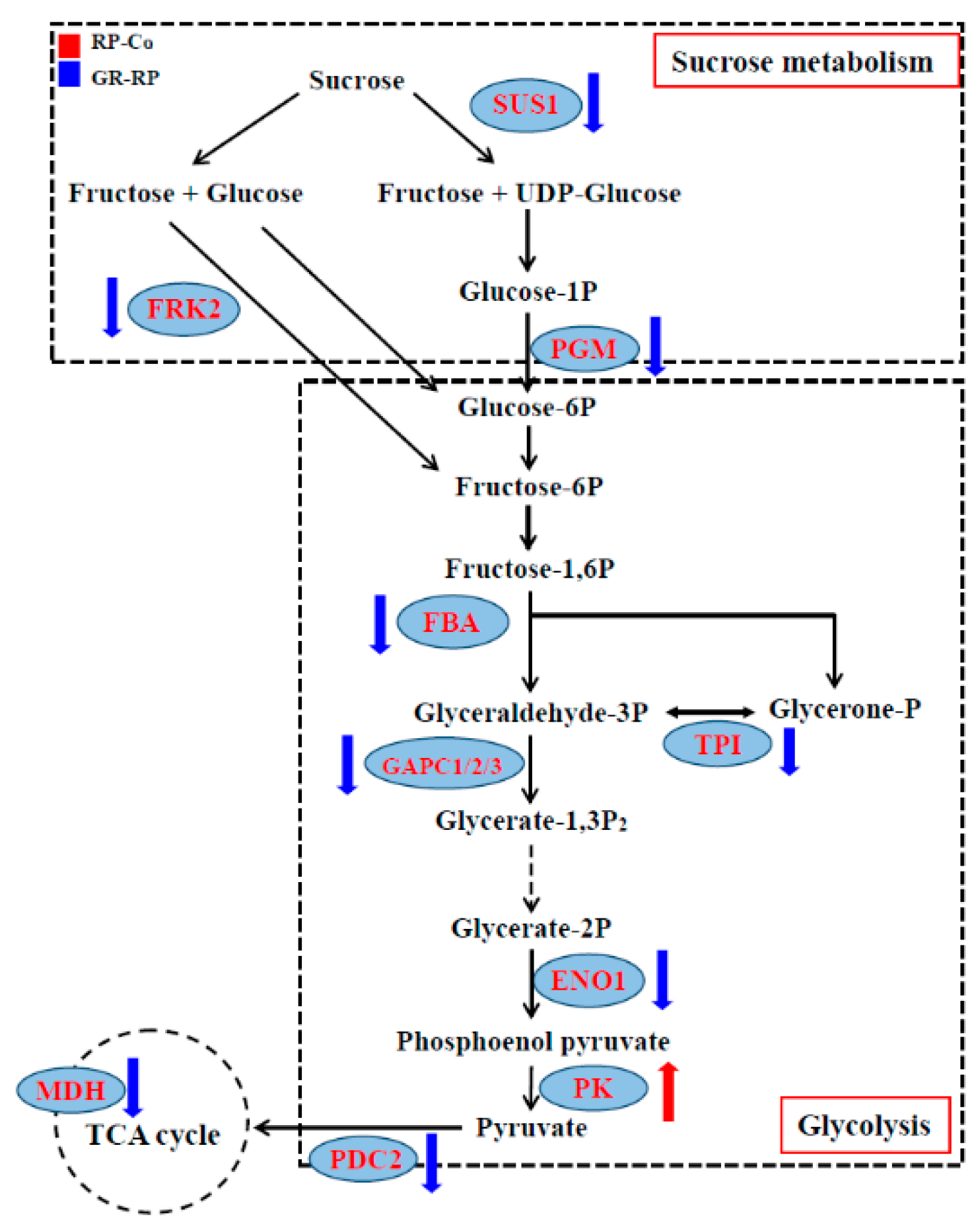Proteomic Analysis Revealed the Antagonistic Effect of Decapitation and Strigolactones on the Tillering Control in Rice
Abstract
:1. Introduction
2. Materials and Methods
2.1. Plant Growth
2.2. Treatments
2.3. iTRAQ Protein Identification and Bioinformatics Analysis
2.4. Detection of Sucrose Content in the Bud
2.5. Enzyme Activities Analysis
2.6. Statistical Calculations
3. Results
3.1. Effects of Panicle Remove (RP) and rac-GR24 (GR) Treatment on Bud Growth in Rice
3.2. Differentially Abundant Protein Analysis
3.3. Go and KEGG Classification of DAPs Analysis
3.4. Response of Protein Processing in the Endoplasmic Reticulum and Ribosome Biogenesis to the Effect of RP
3.5. Response of Sucrose Metabolism to the Effect of RP and GR
4. Discussion
5. Conclusions
Supplementary Materials
Author Contributions
Funding
Data Availability Statement
Conflicts of Interest
References
- Li, X.; Qian, Q.; Fu, Z.; Wang, Y.; Xiong, G.; Zeng, D.; Wang, X.; Liu, X.; Teng, S.; Hiroshi, F.; et al. Control of tillering in rice. Nature 2003, 422, 618–621. [Google Scholar] [CrossRef]
- Arite, T.; Iwata, H.; Ohshima, K.; Maekawa, M.; Nakajima, M.; Kojima, M.; Sakakibara, H.; Kyozuka, J. Dwarf10, an Rms1/Max4/Dad1 Ortholog, Controls Lateral Bud Outgrowth in Rice. Plant J. 2007, 6, 1019–1029. [Google Scholar] [CrossRef]
- Yang, L.; Wang, Q.S.; Ding, Y.F.; Li, G.H.; Xu, J.X.; Wang, S.H. Effects of External Aba, Ga3 and Naa on the Tiller Bud Outgrowth of Rice Is Related to Changes in Endogenous Hormones. Plant Growth Regul. 2011, 65, 247–254. [Google Scholar] [CrossRef]
- Zha, M.R.; Imran, M.; Wang, Y.; Xu, J.X.; Ding, Y.; Wang, S.H. Transcriptome Analysis Revealed the Interaction among Strigolactones, Auxin, and Cytokinin in Controlling the Shoot Branching of Rice. Plant Cell Rep. 2019, 38, 279–293. [Google Scholar] [CrossRef]
- Balla, J.; Kalousek, P.; Reinöhl, V.; Friml, J.; Procházka, S. Competitive Canalization of Pin-Dependent Auxin Flow from Axillary Buds Controls Pea Bud Outgrowth. Plant J. 2011, 65, 571–577. [Google Scholar] [CrossRef]
- Bennett, T.; Hines, G.; Rongen, M.V.; Waldie, T.; Sawchuk, M.G.; Scarpella, E.; Ljung, K.; Leyser, O. Connective Auxin Transport in the Shoot Facilitates Communication between Shoot Apices. PLoS Biol. 2016, 14, e1002446. [Google Scholar] [CrossRef]
- Brewer, P.B.; Dun, E.A.; Ferguson, B.J.; Rameau, C.; Beveridge, C.A. Strigolactone Acts Downstream of Auxin to Regulate Bud Outgrowth in Pea and Arabidopsis. Plant Physiol. 2009, 150, 482–493. [Google Scholar] [CrossRef]
- Shimizu-Sato, S.; Tanaka, M.; Mori, H. Auxin-Cytokinin Interactions in the Control of Shoot Branching. Plant Mol. Biol. 2009, 69, 429–435. [Google Scholar] [CrossRef] [PubMed]
- Zha, M.R.; Zhao, Y.H.; Wang, Y.; Chen, B.X.; Tan, Z.C. Strigolactones and Cytokinin Interaction in Buds in the Control of Rice Tillering. Front. Plant Sci. 2022, 13, 837136. [Google Scholar] [CrossRef]
- Duan, J.; Yu, H.; Yuan, K.; Liao, Z.; Meng, X.; Jing, Y.; Liu, G.; Chu, J.; Li, J. Strigolactone Promotes Cytokinin Degradation through Transcriptional Activation of Cytokinin Oxidase/Dehydrogenase 9 in Rice. Proc. Natl. Acad. Sci. USA 2019, 116, 14319–14324. [Google Scholar] [CrossRef]
- Dun, E.A.; Germain, A.S.; Rameau, C.; Beveridge, R.C. Antagonistic Action of Strigolactone and Cytokinin in Bud Outgrowth Control. Plant Physiol. 2012, 158, 487–498. [Google Scholar] [CrossRef]
- Braun, N.; Germain, A.S.; Pillot, J.P.; Boutet-Mercey, S.; Dalmais, M.; Antoniadi, I.; Li, X.; Maia-Grondard, A.; Signor, C.L.; Bouteiller, N.; et al. The Pea Tcp Transcription Factor Psbrc1 Acts Downstream of Strigolactones to Control Shoot Branching. Plant Physiol. 2012, 158, 225–238. [Google Scholar] [CrossRef]
- Morris, S.E.; Cox, M.C.H.; Ross, J.J.; Krisantini, S.; Beveridge, C.A. Auxin Dynamics after Decapitation Are Not Correlated with the Initial Growth of Axillary Buds. Plant Physiol. 2005, 138, 1665–1672. [Google Scholar] [CrossRef]
- Ferguson, B.J.; Beveridge, C.A. Roles for Auxin, Cytokinin, and Strigolactone in Regulating Shoot Branching. Plant Physiol. 2009, 149, 1929–1944. [Google Scholar] [CrossRef]
- Müller, D.; Waldie, T.; Miyawaki, K.; To, J.P.C.; Melnyk, C.W.; Kieber, J.J.; Kakimoto, T.; Leyser, O. Cytokinin Is Required for Escape but Not Release from Auxin Mediated Apical Dominance. Plant J. 2015, 5, 874–886. [Google Scholar] [CrossRef]
- Adamowski, M.; Friml, J. PIN-Dependent Auxin Transport: Action, Regulation, and Evolution. Plant Cell 2015, 27, 20–32. [Google Scholar] [CrossRef]
- Kebrom, T.H.; Chandler, P.M.; Swain, S.M.; King, R.W.; Richards, R.A.; Spielmeyer, W. Inhibition of Tiller Bud Outgrowth in the Tin Mutant of Wheat Is Associated with Precocious Internode Development. Plant Physiol. 2012, 160, 308–318. [Google Scholar] [CrossRef]
- Mason, M.G.; Ross, J.J.; Babst, B.A.; Wienclaw, B.N.; Beveridge, C.A. Sugar Demand, Not Auxin, Is the Initial Regulator of Apical Dominance. Proc. Natl. Acad. Sci. USA 2014, 111, 6092–6097. [Google Scholar] [CrossRef]
- Barbier, F.F.; Lunn, J.E.; Beveridge, C.A. Ready, Steady, Go! A Sugar Hit Starts the Race to Shoot Branching. Curr. Opin. Plant Biol. 2015, 25, 39–45. [Google Scholar] [CrossRef]
- Dierck, R.; Dhooghe, E.; Huylenbroeck, J.V.; Riek, J.D.; Keyser, E.D.; Straeten, D.V.D. Response to Strigolactone Treatment in Chrysanthemum Axillary Buds Is Influenced by Auxin Transport Inhibition and Sucrose Availability. Acta Physiol. Plant. 2016, 38, 271. [Google Scholar] [CrossRef]
- Tarancón, C.; González-Grandío, E.; Oliveros, J.C.; Nicolas, M.; Cubas, P. A Conserved Carbon Starvation Response Underlies Bud Dormancy in Woody and Herbaceous Species. Front. Plant Sci. 2017, 8, 788. [Google Scholar] [CrossRef]
- Wang, F.; Han, T.; Song, Q.X.; Ye, W.X.; Song, X.G.; Chu, J.F.; Li, J.Y.; Chen, Z.J. The Rice Circadian Clock Regulates Tiller Growth and Panicle Development through Strigolactone Signaling and Sugar Sensing. Plant Cell 2020, 32, 3124–3138. [Google Scholar] [CrossRef]
- Kebrom, T.H.; Mullet, J.E. Transcriptome Profiling of Tiller Buds Provides New Insights into Phyb Regulation of Tillering and Indeterminate Growth in Sorghum. Plant Physiol. 2016, 170, 2232–2250. [Google Scholar] [CrossRef]
- Kebrom, T.H.; Mullet, J.E. Photosynthetic Leaf Area Modulates Tiller Bud Outgrowth in Sorghum. Plant Cell Environ. 2015, 38, 1471–1478. [Google Scholar] [CrossRef]
- Kebrom, T.H. A Growing Stem Inhibits Bud Outgrowth—The Overlooked Theory of Apical Dominance. Front. Plant Sci. 2017, 8, 1874. [Google Scholar] [CrossRef]
- Lemoine, R.; Camera, S.L.; Atanassova, R.; Dedaldechamp, F.; Allario, T.; Pourtau, N.; Bonnemain, J.L.; Laloi, M.; Coutos-Thévenot, P.; Maurousset, L.; et al. Source-to-Sink Transport of Sugar and Regulation by Environmental Factors. Front. Plant Sci. 2013, 4, 272. [Google Scholar] [CrossRef]
- Rabot, A.; Henry, C.; Baaziz, K.B.; Mortreau, E.; Azri, W.; Lothier, J.; Hamama, L.; Boummaza, R.; Leduc, N.; Pelleschi-Travier, S.; et al. Insight into the role of sugars in bud burst under light in the rose. Plant Cell Physiol. 2012, 53, 1068–1082. [Google Scholar] [CrossRef]
- Pasternak, T.; Kircher, S.; Palme, K.; Pérez-Pérez, J.M. Regulation of early seedling establishment and root development in Arabidopsis thaliana by light and carbohydrates. Planta 2023, 258, 76. [Google Scholar] [CrossRef] [PubMed]
- Fichtner, F.; Barbier, F.F.; Feil, R.; Watanabe, M.; Annunziata, M.G.; Chabikwa, T.G.; Hofgen, R.; Stitt, M.; Beveridge, C.A.; Lunn, J.E. Trehalose 6-Phosphate Is Involved in Triggering Axillary Bud Outgrowth in Garden Pea (Pisum sativum L.). Plant J. 2017, 92, 611–623. [Google Scholar] [CrossRef] [PubMed]
- Barbier, F.; Cao, D.; Fichtner, F.; Weiste, C.; Pérez-Garcia, M.; Caradeuc, M.; Gourrierec, J.L.; Sakr, S.; Beveridge, C.A. Hexokinase1 Signalling Promotes Shoot Branching and Interacts with Cytokinin and Strigolactone Pathways. New Phytol. 2021, 231, 1088–1104. [Google Scholar] [CrossRef] [PubMed]
- Wang, G.P.; Wu, Y.; Ma, L.; Lin, Y.; Hu, Y.X.; Li, M.Z.; Li, W.W.; Ding, Y.F.; Chen, L. Phloem Loading in Rice Leaves Depends Strongly on the Apoplastic Pathway. J. Exp. Bot. 2021, 72, 3723–3738. [Google Scholar] [CrossRef]
- Patil, S.B.; Barbier, F.F.; Zhao, J.; Zafar, S.A.; Uzair, M.; Sun, Y.; Fang, J.; Perez-Garcia, M.D.; Bertheloot, J.; Sakr, S.; et al. Sucrose promotes D53 accumulation and tillering in rice. New Phytol. 2022, 234, 122–136. [Google Scholar] [CrossRef]
- Barbier, F.; Péron, T.; Lecerf, M.; Perez-Garcia, M.D.; Barrière, Q.; Rolčík, J.; Boutet-Mercey, S.; Citerne, S.; Lemoine, R.; Porcheron, B.; et al. Sucrose is an early modulator of the key hormonal mechanisms controlling bud outgrowth in Rosa hybrida. J. Exp. Bot. 2015, 66, 2569–2582. [Google Scholar] [CrossRef]
- Zhang, H.F.; Ma, H.Y.; Xie, X.; Ji, J.; Zhang, Z.G. Comparative Proteomic Analyses Reveal That the Regulators of G-Protein Signaling Proteins Regulate Amino Acid Metabolism of the Rice Blast Fungus Magnaporthe Oryzae. Proteomics 2015, 14, 21–22. [Google Scholar] [CrossRef]
- Kanehisa, M.; Goto, S.; Sato, Y.; Kawashima, M.; Furumichi, M.; Tanabe, M. Data, Information, Knowledge and Principle: Back to Metabolism in Kegg. Nucleic Acids Res. 2013, 42, 199–205. [Google Scholar] [CrossRef]
- Kornprobst, M.; Turk, M.; Kellner, N.; Cheng, J.D.; Flemming, D.; Koš-Braun, I.; Koš, M.; Thoms, M.; Berninghausen, O.; Beckmann, R. Architecture of the 90s Pre-Ribosome: A Structural View on the Birth of the Eukaryotic Ribosome. Cell 2016, 166, 380–393. [Google Scholar] [CrossRef]
- Tran, E.J.; Zhang, X.; Maxwell, E.S. Efficient Rna 2′-O-methylation Requires Juxtaposed and Symmetrically Assembled Archaeal Box C/D and C′/D′ RNPs. EMBO J. 2003, 22, 3930–3940. [Google Scholar] [CrossRef]
- Dragon, F.; Gallagher, J.E.G.; Compagnone-Post, P.A.; Mitchell, B.M.; Porwancher, K.A.; Wehner, K.A.; Wormsley, S.; Settlage, R.E.; Shabanowitz, J.; Osheim, Y.; et al. A Large Nucleolar U3 Ribonucleoprotein Required for 18s Ribosomal Rna Biogenesis. Nature 2002, 417, 967–970. [Google Scholar] [CrossRef]
- Leyser, O. The Control of Shoot Branching: An Example of Plant Information Processing. Plant Cell Environ. 2009, 32, 694–703. [Google Scholar] [CrossRef]
- Rameau, C.; Bertheloot, J.; Leduc, N.; Andrieu, B.; Foucher, F.; Sakr, S. Multiple Pathways Regulate Shoot Branching. Front. Plant Sci. 2015, 5, 741. [Google Scholar] [CrossRef]
- Al-Babili, S.; Bouwmeester, H. Strigolactones, a Novel Carotenoid-Derived Plant Hormone. Annu. Rev. Plant Biol. 2015, 66, 161–186. [Google Scholar] [CrossRef]
- Bertheloot, J.; Barbier, F.; Boudon, F.; Perez-Garcia, M.D.; Péron, T.; Citerne, S.; Dun, E.; Beveridge, C.; Godin, C.; Sakr, S. Sugar availability suppresses the auxin-induced strigolactone pathway to promote bud outgrowth. New Phytol. 2020, 225, 866–879. [Google Scholar] [CrossRef]
- Brewer, P.B.; Dun, E.A.; Gui, R.; Mason, M.G.; Beveridge, C.A. Strigolactone Inhibition of Branching Independent of Polar Auxin Transport. Plant Physiol. 2015, 168, 1820–1829. [Google Scholar] [CrossRef]
- Gomez-Roldan, V.; Fermas, S.; Brewer, P.B.; Puech-Pages, V.; Dun, E.A.; Pillot, J.P.; Letisse, F.; Matusova, R.; Danoun, S.; Portais, J.C.; et al. Strigolactone Inhibition of Shoot Branching. Nature 2008, 455, 189–194. [Google Scholar] [CrossRef]
- Hayward, A.; Stirnberg, P.; Beveridge, C.; Leyser, O. Interactions between Auxin and Strigolactone in Shoot Branching Control. Plant Physiol. 2009, 151, 400–412. [Google Scholar] [CrossRef]
- Liu, Z.; Lv, Y.; Zhao, N.; Guan, G.; Wang, J. Protein Kinase R-Like Er Kinase and Its Role in Endoplasmic Reticulum Stress-Decided Cell Fate. Cell Death Dis. 2015, 6, e1822. [Google Scholar] [CrossRef]
- Schwarz, D.S.; Blower, M.D. The Endoplasmic Reticulum: Structure, Function and Response to Cellular Signaling. Cell. Mol. Life Sci. 2016, 73, 79–94. [Google Scholar] [CrossRef]
- Weis, B.L.; Kovacevic, J.; Missbach, S.; Schleiff, E. Plant-Specific Features of Ribosome Biogenesis. Trends Plant Sci. 2015, 20, 729–740. [Google Scholar] [CrossRef]
- Palm, D.; Streit, D.; Shanmugam, T.; Weis, B.L.; Ruprecht, M.; Simm, S.; Schleiff, E. Plant-Specific Ribosome Biogenesis Factors in Arabidopsis Thaliana with Essential Function in Rrna Processing. Nucleic Acids Res. 2019, 4, 1880–1895. [Google Scholar] [CrossRef]
- Ljung, K.; Nemhauser, J.L.; Perata, P. New Mechanistic Links between Sugar and Hormone Signalling Networks. Curr. Opin. Plant Biol. 2015, 25, 130–137. [Google Scholar] [CrossRef]
- Smith, C.R.; Knowles, V.L.; Plaxton, W.C. Purification and Characterization of Cytosolic Pyruvate Kinase from Brassica Napus (Rapeseed) Suspension Cell Cultures: Implications for the Integration of Glycolysis with Nitrogen Assimilation. Eur. J. Biochem. 2000, 267, 4477–4485. [Google Scholar] [CrossRef]
- Sergeeva, L.; Keurentjes, J.J.B.; Bentsink, L.; Vonk, J.; VanDerPlas, L.H.W.; Koornneef, M.; Vreugdenhil, D. Vacuolar Invertase Regulates Elongation of Arabidopsis Thaliana Roots as Revealed by Qtl and Mutant Analysis. Proc. Natl. Acad. Sci. USA 2006, 103, 2994–2999. [Google Scholar] [CrossRef]
- Jain, R.; Singh, S.P.; Singh, A.; Singh, S.; Kishor, R.; Singh, R.K.; Chandra, A.; Solomon, S. Soluble Acid Invertase (Sai) Activity and Gene Expression Controlling Sugar Composition in Sugarcane. Sugar Tech. 2017, 19, 669–674. [Google Scholar] [CrossRef]
- Schmlzer, K.; Gutmann, A.; Diricks, M.; Desmet, T.; Nidetzky, B. Sucrose Synthase: A Unique Glycosyltransferase for Biocatalytic Glycosylation Process Development. Biotechnol. Adv. 2016, 34, 88–111. [Google Scholar] [CrossRef]
- Goren, S.; Lugassi, N.; Stein, O.; Yeselson, Y.; Schaffer, A.A.; David-Schwartz, R.; Granot, D. Suppression of Sucrose Synthase Affects Auxin Signaling and Leaf Morphology in Tomato. PLoS ONE 2017, 12, e0182334. [Google Scholar] [CrossRef]
- Ruan, Y.L. Sucrose metabolism: Gateway to diverse carbon use and sugar signaling. Annu. Rev. Plant Biol. 2014, 65, 33–67. [Google Scholar] [CrossRef]
- Barratt, D.H.; Derbyshire, P.; Findlay, K.; Pike, M.; Wellner, N.; Lunn, J.; Feil, R.; Simpson, C.; Maule, A.J.; Smith, A.M. Normal growth of Arabidopsis requires cytosolic invertase but not sucrose synthase. Proc. Natl. Acad. Sci. USA 2009, 106, 13124–13129. [Google Scholar] [CrossRef]
- Cao, D.; Chabikwa, T.; Barbier, F.; Dun, E.A.; Fichtner, F.; Dong, L.L.; Kerr, S.C.; Beveridge, C.A. Auxin-Independent Effects of Apical Dominance Induce Changes in Phytohormones Correlated with Bud Outgrowth. Plant Physiol. 2023, 192, 1420–1434. [Google Scholar] [CrossRef]
- Kircher, S.; Schopfer, P. Photosynthetic sucrose drives the lateral root clock in Arabidopsis seedlings. Curr. Biol. 2023, 33, 2201–2212. [Google Scholar] [CrossRef]
- Pasternak, T.; Lystvan, K.; Betekhtin, A.; Hasterok, R. From Single Cell to Plants: Mesophyll Protoplasts as a Versatile System for Investigating Plant Cell Reprogramming. Int. J. Mol. Sci. 2020, 21, 4195. [Google Scholar] [CrossRef]
- Pasternak, T.; Miskolczi, P.C.; Ayaydin, F.; Mészáros, T.; Dudits, D.; Fehér, A. Exogenous auxin and cytokinin dependent activation of CDKs and cell division in leaf protoplast-derived cells of alfalfa. Plant Growth Regul. 2000, 32, 129–141. [Google Scholar] [CrossRef]
- Cañas, R.A.; Yesbergenova-Cuny, Z.; Simons, M.; Chardon, F.; Armengaud, P.; Quilleré, I.; Cukier, C.; Gibon, Y.; Limami, A.M.; Nicolas, S.; et al. Exploiting the Genetic Diversity of Maize Using a Combined Metabolomic, Enzyme Activity Profiling, and Metabolic Modeling Approach to Link Leaf Physiology to Kernel Yield. Plant Cell 2017, 29, 919–943. [Google Scholar] [CrossRef] [PubMed]
- Wang, M.; Pérez-Garcia, M.; Davière, J.; Barbier, F.; Ogé, L.; Gentilhomme, J.; Voisine, L.; Péron, T.; Launay-Avon, A.; Clément, G.; et al. Axillary bud outgrowth in rose is controlled by sugar metabolic and signalling pathways. J. Exp. Bot. 2021, 72, 3044–3060. [Google Scholar] [CrossRef] [PubMed]






| Gene Name | ID | RP-Co Fold Change | GR-RP Fold Change | Protein Name |
|---|---|---|---|---|
| Protein processing in endoplasmic reticulum | ||||
| LOC_Os04g36750 | Q7XUW5 | 0.3131 | NS | 23.2 kDa heat shock protein, HSP23.2 |
| LOC_Os03g15960 | Q84Q77 | 0.408783 | NS | 17.9 kDa heat shock protein 1, OsHsp17.9A |
| LOC_Os01g04360 | Q943E7 | 0.44715 | NS | 16.9 kDa heat shock protein 3, OsHsp16.9C |
| LOC_Os01g08860 | Q5VRY1 | 0.455117 | NS | 18.0 kDa heat shock protein, OsHsp18.0 |
| LOC_Os03g14180 | Q10P60 | 0.4746 | NS | 26.7 kDa heat shock protein, chloroplastic, OsHsp26.7 |
| LOC_Os03g16030 | Q84Q72 | 0.47555 | NS | 18.1 kDa heat shock protein, OsHsp18.1) |
| LOC_Os12g37360 | Q2QNM5 | 2.52055 | NS | GTP-binding protein, SAR1 |
| LOC_Os02g02410 | Q6Z7B0 | 2.383533 | NS | Luminal-binding protein 3, BIP3 |
| LOC_Os08g39140 | Q0J4P2 | 4.257 | NS | molecular chaperone HtpG |
| LOC_Os03g44620 | Q84PD0 | 3.266967 | NS | DnaJ homolog subfamily A member 2 |
| LOC_Os03g57340 | Q6F3B0 | 5.60965 | NS | DnaJ homolog subfamily A member 2 |
| LOC_Os08g38086 | Q6ZCV7 | 2.38195 | NS | heat shock protein 90kDa beta, GFP94 |
| LOC_Os12g14070 | Q2QV45 | 2.457367 | NS | Stromal 70 kDa heat shock-related protein, chloroplast, putative, expressed |
| LOC_Os10g30580 | Q0IXF3 | 2.8404 | NS | cell division control protein 48 homolog E, putative, expressed |
| LOC_Os03g60620 | Q84TA1 | 3.6153 | NS | Heat shock cognate 70 kDa protein 2, putative, expressed |
| LOC_Os11g47760 | Q53NM9 | 3.63135 | NS | Heat shock cognate 70 kDa protein, putative, expressed |
| LOC_Os12g32986 | Q0IN14 | 3.841017 | NS | Hsp90 protein, expressed |
| LOC_Os02g16040 | Q8S919 | 4.47095 | NS | Ubiquitin-conjugating enzyme E2 5B |
| LOC_Os03g16860 | Q10NA9 | 5.691567 | NS | 70 kDa heat shock protein |
| Ribosome biogenesis in eukaryotes | ||||
| LOC_Os07g41190 | Q6YW01 | 2.025283 | NS | U3 small nucleolar RNA-associated protein 18, UTP18 |
| LOC_Os02g02360 | Q6Z7B7 | 2.387583 | NS | RNA-binding protein, NOB1 |
| LOC_Os06g16290 | Q9FP19 | 2.615183 | NS | H/ACA ribonucleoprotein complex subunit 2, NHP2 |
| LOC_Os03g21530 | Q0DS53 | 2.894683 | NS | ribosome biogenesis protein, BMS1 |
| LOC_Os01g27730 | Q5ZCV4 | 3.514833 | NS | nuclear GTP-binding protein, Nug2 |
| LOC_Os12g07300 | Q0IPS3 | 4.16415 | NS | N-acetyltransferase 10, KRE33 |
| Gene Name | ID | RP-Co Fold Change | GR-RP Fold Change | Protein Name |
|---|---|---|---|---|
| LOC_Os10g42100 | Q8S7N6 | 3.188566667 | NS | Pyruvate kinase (PK) |
| LOC_Os08g03290 | Q0J8A4 | NS | 0.391 | Glyceraldehyde-3-phosphate dehydrogenase 1 (GAPC1), cytosolic |
| LOC_Os04g40950 | Q7FAH2 | NS | 0.455 | Glyceraldehyde-3-phosphate dehydrogenase 2 (GAPC1), cytosolic |
| LOC_Os02g38920 | Q6K5G8 | NS | 0.490 | Glyceraldehyde-3-phosphate dehydrogenase 3 (GAPC1), cytosolic |
| LOC_Os03g18220 | Q10MW3 | NS | 0.427 | Pyruvate decarboxylase 2 |
| LOC_Os10g08550 | Q42971 | NS | 0.470 | Enolase (ENO1) |
| LOC_Os10g11140 | Q33AE4 | NS | 0.401 | Phosphoglucomutase (PGM, alpha-D-glucose-1,6-bisphosphate-dependent) |
| LOC_Os01g67860 | Q5N725 | NS | 0.468 | Fructose-bisphosphate aldolase 3 (FBA3), cytoplasmic |
| LOC_Os01g05490 | Q0JQP8 | NS | 0.486 | Triosephosphate isomerase (TPI), cytosolic |
| LOC_Os03g28330 | P31924 | NS | 0.425 | Sucrose synthase 1 (SUS1) |
| LOC_Os08g02120 | Q0J8G4 | NS | 0.497 | Fructokinase-2 (FRK2) |
| LOC_Os10g33800 | Q7XDC8 | NS | 0.451 | Malate dehydrogenase (MDH), cytoplasmic |
Disclaimer/Publisher’s Note: The statements, opinions and data contained in all publications are solely those of the individual author(s) and contributor(s) and not of MDPI and/or the editor(s). MDPI and/or the editor(s) disclaim responsibility for any injury to people or property resulting from any ideas, methods, instructions or products referred to in the content. |
© 2023 by the authors. Licensee MDPI, Basel, Switzerland. This article is an open access article distributed under the terms and conditions of the Creative Commons Attribution (CC BY) license (https://creativecommons.org/licenses/by/4.0/).
Share and Cite
Zhao, Y.; Zha, M.; Xu, C.; Hou, F.; Wang, Y. Proteomic Analysis Revealed the Antagonistic Effect of Decapitation and Strigolactones on the Tillering Control in Rice. Plants 2024, 13, 91. https://doi.org/10.3390/plants13010091
Zhao Y, Zha M, Xu C, Hou F, Wang Y. Proteomic Analysis Revealed the Antagonistic Effect of Decapitation and Strigolactones on the Tillering Control in Rice. Plants. 2024; 13(1):91. https://doi.org/10.3390/plants13010091
Chicago/Turabian StyleZhao, Yanhui, Manrong Zha, Congshan Xu, Fangxu Hou, and Yan Wang. 2024. "Proteomic Analysis Revealed the Antagonistic Effect of Decapitation and Strigolactones on the Tillering Control in Rice" Plants 13, no. 1: 91. https://doi.org/10.3390/plants13010091
APA StyleZhao, Y., Zha, M., Xu, C., Hou, F., & Wang, Y. (2024). Proteomic Analysis Revealed the Antagonistic Effect of Decapitation and Strigolactones on the Tillering Control in Rice. Plants, 13(1), 91. https://doi.org/10.3390/plants13010091






